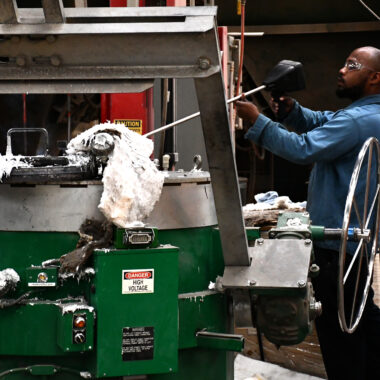About Aluminum Casting Chronicles: Methods, Trends, and Tips
Wiki Article
Crafting Excellence: Exactly How to Achieve High-Quality Light Weight Aluminum Castings Every Time
In the world of aluminum spreading, the pursuit of excellence is a continual trip that calls for a careful approach and a keen understanding of the details involved. Attaining consistent top quality aluminum spreadings requires a detailed grasp of the procedures, from selecting the suitable alloy to carrying out specific mold designs and diligently regulating spreading criteria. The real proficiency lies in the capability to apply these elements effortlessly to create flawless spreadings every time. As we explore the intricacies of crafting perfection in light weight aluminum spreadings, uncovering the essential approaches and techniques that lead to impeccable results becomes vital for those pursuing excellence in this specialized area.Recognizing Light Weight Aluminum Casting Processes
Light weight aluminum casting procedures, crucial in the production market, involve the elaborate transformation of molten aluminum into strong kinds with a collection of very carefully controlled steps. Understanding these procedures is extremely important to accomplishing premium light weight aluminum spreadings consistently - about aluminum casting. The key approaches used in aluminum casting are pass away casting, sand casting, and investment spreading
Each of these procedures has its benefits and is picked based on elements like complexity, volume, and preferred coating of the aluminum spreading. about aluminum casting. Understanding the ins and outs of these techniques is critical for makers aiming to produce premium aluminum spreadings consistently
Picking the Right Aluminum Alloy
Picking the proper light weight aluminum alloy is a crucial choice in the production of top notch aluminum castings. When selecting an aluminum alloy for casting, it is crucial to consider the particular needs of the application to ensure optimal efficiency.One of the most frequently used light weight aluminum alloys for casting is A356 - about aluminum casting. For applications requiring high strength, 7075 light weight aluminum alloy is a preferred option due to its phenomenal strength-to-weight proportion.
In addition to mechanical properties, considerations such as price, accessibility, and post-casting procedures must also affect the selection of the right light weight aluminum alloy. By very carefully reviewing these variables, manufacturers can guarantee the production of top notch aluminum castings that fulfill the preferred specs.
Carrying Out Correct Mold Style
Establishing an effective mold design is critical for ensuring the successful manufacturing of top quality aluminum spreadings. Proper mold and mildew style plays a substantial role in accomplishing the desired features of the last item. To apply an effective mold and mildew design, variables such as product flow, cooling down prices, and component geometry must be meticulously thought about.One secret element of mold and mildew design is guaranteeing appropriate look at here now filling and solidification of the aluminum within the mold dental caries. This includes making runner and gating systems that assist in smooth metal circulation and protect against flaws such as air entrapment or incomplete filling. Additionally, including cooling channels into the mold design aids manage solidification rates and reduce the threat of porosity or shrinking issues.

Controlling Casting Parameters

Making Sure Post-Casting High Quality Checks
To keep the excellent quality of light weight aluminum castings, complete post-casting quality checks are essential. After the spreading procedure is finished, it is essential to ensure that the end products satisfy the desired requirements and specs. One of the key top quality checks includes inspecting the surface finish of the castings to recognize any kind of defects such as porosity, splits, or surface area abnormalities. This aesthetic evaluation is usually supplemented by non-destructive testing methods like ultrasonic testing or dye penetrant assessment to identify internal imperfections that may endanger the honesty of the spreading.Dimensional accuracy is another crucial aspect that has to be confirmed throughout post-casting high quality checks. Dimensions of vital dimensions and resistances should be taken to confirm that the spreadings adapt the required requirements. In addition, mechanical buildings such as firmness, tensile stamina, and influence resistance may need to be reviewed with product screening to ensure that the castings possess the necessary toughness and resilience for their designated application.
Verdict
site here To conclude, attaining high-grade light weight aluminum spreadings needs a comprehensive understanding of the spreading processes, picking the suitable alloy, making mold and mildews explanation properly, controlling casting specifications diligently, and carrying out post-casting quality checks faithfully. By adhering to these actions, producers can consistently create aluminum castings that satisfy the highest requirements of high quality and performance.Accomplishing regular top notch light weight aluminum castings demands a thorough grasp of the procedures, from choosing the proper alloy to executing specific mold and mildew layouts and diligently managing casting criteria. The key techniques made use of in aluminum spreading are pass away casting, sand spreading, and financial investment spreading.
Financial investment casting, likewise known as accuracy casting, involves creating wax patterns that are coated in ceramic to develop molds.Choosing the proper aluminum alloy is an important choice in the manufacturing of top notch light weight aluminum spreadings.Making certain specific control over casting specifications is crucial for maintaining uniformity and top quality in light weight aluminum casting production.
Report this wiki page